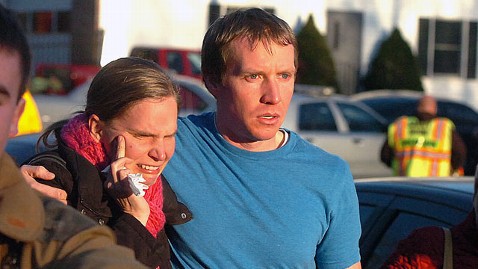Thomas K. Grose in London
The starting gun has sounded for the United Kingdom's "dash for gas," as the media here have dubbed it.
As early as this week, a moratorium on shale gas production is expected to be lifted. And plans to streamline and speed the regulatory process through a new Office for Unconventional Gas and Oil were unveiled last week in the annual autumn budget statement by the chancellor of the exchequer, George Osborne.
In the U.K., where all underground mineral rights concerning fossil fuels belong to the crown, hydraulic fracturing, or fracking, could unlock a new stream of government revenue as well as fuel. But it also means that there is no natural constituency of fracking supporters as there is in the United States, birthplace of the technology. In the U.S., concerns over land and water impact have held back fracking in some places, like New York, but production has advanced rapidly in shale basins from Texas to Pennsylvania, with support of private landowners who earn royalties from leasing to gas companies. (Related: "Natural Gas Stirs Hope and Fear in Pennsylvania")
A taste of the fight ahead in the U.K. came ahead of Osborne's speech last weekend, when several hundred protesters gathered outside of Parliament with a mock 23-foot (7-meter) drilling rig. In a letter they delivered to Prime Minister David Cameron, they called fracking "an unpredictable, unregulatable process" that was potentially toxic to the environment.
Giving shale gas a green light "would be a costly mistake," said Andy Atkins, executive director of the U.K.'s Friends of the Earth, in a statement. "People up and down the U.K. will be rightly alarmed about being guinea pigs in Osborne's fracking experiment. It's unnecessary, unwanted and unsafe."
The government has countered that natural gas-fired power plants would produce half the carbon dioxide emissions of the coal plants that still provide about 30 percent of the U.K.'s electricity. London Mayor Boris Johnson, viewed as a potential future prime minister, weighed in Monday with a blistering cry for Britain to "get fracking" to boost cleaner, cheaper energy and jobs. "In their mad denunciations of fracking, the Greens and the eco-warriors betray the mindset of people who cannot bear a piece of unadulterated good news," he wrote in the Daily Telegraph. (Related Quiz: "What You Don't Know About Natural Gas")
Energy Secretary Edward Davey, who is expected this week to lift the U.K.'s year-and-a-half-old moratorium on shale gas exploration, said gas "will ensure we can keep the lights on as increasing amounts of wind and nuclear come online through the 2020s."
A Big Role for Gas
If the fracking plan advances, it will not be the first "dash for gas" in the U.K. In the 1980s, while Prime Minister Margaret Thatcher battled with mining unions, she undercut their clout by moving the nation toward generating a greater share of its electricity from natural gas and less from coal. So natural gas already is the largest electricity fuel in Britain, providing 40 percent of electricity. (Related Interactive: "World Electricity Mix")
The United Kingdom gets about 10 percent of its electricity from renewable energy, and has plans to expand its role. But Davey has stressed the usefulness of gas-fired plants long-term as a flexible backup source to the intermittent electricity generated from wind and solar power. Johnson, on the other hand, offered an acerbic critique of renewables, including the "satanic white mills" he said were popping up on Britain's landscape. "Wave power, solar power, biomass—their collective oomph wouldn't pull the skin off a rice pudding," he wrote.
As recently as 2000, Great Britain was self-sufficient in natural gas because of conventional gas production in the North Sea. But that source is quickly drying up. North Sea production peaked in 2000 at 1,260 terawatt-hours (TWH); last year it totaled just 526 TWh.
Because of the North Sea, the U.K. is still one of the world's top 20 producers of gas, accounting for 1.5 percent of total global production. But Britain has been a net importer of gas since 2004. Last year, gas imports—mainly from Norway, Belgium, and the Netherlands—accounted for more than 40 percent of domestic demand.
The government hopes to revive domestic natural gas production with the technology that has transformed the energy picture in the United States—horizontal drilling into deep underground shale, and high-pressure injection of water, sand, and chemicals to create fissures in the rock to release the gas. (Related Interactive: "Breaking Fuel From the Rock")
A Tougher Road
But for a number of reasons, the political landscape is far different in the United Kingdom. Britain made a foray into shale gas early last year, with a will drilled near Blackpool in northwest England. The operator, Cuadrilla, said that that area alone could contain 200 trillion cubic feet of gas, which is more than the known reserves of Iraq. But the project was halted after drilling, by the company's own admission, caused two small earthquakes. (Related: "Tracing Links Between Fracking and Earthquakes" and "Report Links Energy Activities To Higher Quake Risk") The April 2011 incident triggered the moratorium that government now appears to be ready to lift. Cuadrilla has argued that modifications to its procedures would mitigate the seismic risk, including lower injection rates and lesser fluid and sand volumes. The company said it will abandon the U.K. unless the moratorium is soon lifted.
A few days ahead of Osborne's speech, the Independent newspaper reported that maps created for Britain's Department of Energy and Climate Change (DECC) showed that 32,000 square miles, or 64 percent of the U.K. countryside, could hold shale gas reserves and thus be open for exploration. But a DECC spokeswoman said "things are not quite what it [the Independent story] suggests." Theoretically, she said, those gas deposits do exist, but "it is too soon to predict the scale of exploration here." She said many other issues, ranging from local planning permission to environmental impact, would mean that some tracts would be off limits, no matter how much reserve they held. DECC has commissioned the British Geological Survey to map the extent of Britain's reserves.
Professor Paul Stevens, a fellow of the Royal Institute of International Affairs, said the U.K. is clearly interested in trying to replicate America's shale gas revolution. "That's an important part of the story," he said, but trying to use the American playbook won't be easy. "It's a totally different ballgame." In addition to the fact that mineral rights belong to the crown, large expanses of private land that are commonplace in America don't exist in England. Just as important, there is no oil- and gas-service industry in place in Britain to quickly begin shale gas operations here. "We don't have the infrastructure set up," said Richard Davies, director of the Durham Energy Institute at Durham University, adding that it would take years to build it.
Shale gas production would also likely ignite bigger and louder protests in the U.K. and Europe. "It's much more of a big deal in Europe," Stevens said. "There are more green [nongovernmental organizations] opposed to it, and a lot more local opposition."
In any case, the U.K. government plans to move ahead. Osborne said he'll soon begin consultations on possible tax breaks for the shale gas industry. He also announced that Britain would build up to 30 new natural gas-fired power plants with 26 gigawatts (GW) of capacity. The new gas plants would largely replace decommissioned coal and nuclear power plants, though they would ultimately add 5GW of additional power to the U.K. grid. The coalition government's plan, however, leaves open the possibility of increasing the amount of gas-generated electricity to 37GW, or around half of total U.K. demand.
The U.S. Energy Information Administration (EIA) estimates that Europe may have as much as 600 trillion cubic feet of shale gas that could be recovered. But Stevens said no European country is ready to emulate the United States in producing massive amounts of unconventional gas. They all lack the necessary service industry, he said, and geological differences will require different technologies. And governments aren't funding the research and development needed to develop them.
Globally, the track record for efforts to produce shale gas is mixed:
- In France, the EIA's estimate is that shale gas reserves total 5 trillion cubic meters, or enough to fuel the country for 90 years. But in September, President Francois Hollande pledged to continue a ban on fracking imposed last year by his predecessor, Nicolas Sarkozy.
- Poland was also thought to have rich shale gas resources, but initial explorations have determined that original estimates of the country's reserves were overstated by 80 percent to 90 percent. After drilling two exploratory wells there, Exxon Mobil stopped operations. But because of its dependence on Russian gas, Poland is still keen to begin shale gas production.
- South Africa removed a ban on fracking earlier this year. Developers are eyeing large shale gas reserves believed to underlie the semidesert Karoo between Johannesburg and Cape Town.
- Canada's Quebec Province has had a moratorium on shale gas exploration and production, but a U.S. drilling company last month filed a notice of intent to sue to overturn the ban as a violation of the North American Free Trade Agreement.
- Germany's Environment Ministry has backed a call to ban fracking near drinking water reservoirs.
- China drilled its initial shale gas wells this year; by 2020, the nation's goal is for shale gas to provide 6 percent of its massive energy needs. The U.S. government's preliminary assessment is that China has the world's largest "technically recoverable" shale resources, about 50 percent larger than stores in the United States. (Related: "China Drills Into Shale Gas, Targeting Huge Reserves")
This story is part of a special series that explores energy issues. For more, visit The Great Energy Challenge.




















